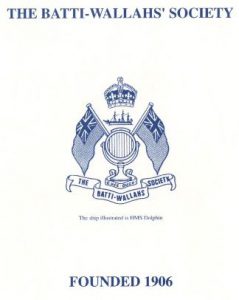- Author
- A.N. Other
- Subjects
- Ship design and development, Naval technology
- Tags
-
- RAN Ships
- None noted.
- Publication
- March 2019 edition of the Naval Historical Review (all rights reserved)
By John McGrath
The President of the Batti-Wallahs’ Society has kindly given us permission to use the following information, with some minor additions, on the history of this unusual maritime association.
Membership of the long established Batti-Wallahs’ Society is drawn from those who serve or have served at sea or in close connection with the sea, and are members of the electrical engineering profession. They meet, usually monthly, with a guest speaker for a luncheon, mainly in London, annually at Portsmouth, and by invitation in various Royal Naval establishments during the year, with occasional visits to other places of technical or historic interest. Here is the rather unusual history of this old society.
Before the advent of the electric arc ‘Search Light’ ships were unable to navigate the confined waters of the Suez Canal during darkness. The Search Light was first used in the Canal and the Red Sea in support of troops on shore by HMS Dolphin, a 950-ton sloop which was fitted with the light in 1884. As related by the Chief ERA of Dolphin – grandfather of one of our Presidents – she was known as ‘The Moonshine Ship’. This was also of interest to the P&O Company whose vessels could not move at night.
The first recorded night passage of the Canal using a Search Light for navigation was by the P&O ship SS Carthagein 1888. The name Dolphin is cherished by Batti-Wallahs for the above good reason, but also because her last years were spent as a submarine depot ship at Fort Blockhouse, Portsmouth to which she gave her name – a name with pleasant luncheon memories for latter day Batti-Wallahs.
In origin a Batti-Wallah came from the bottom rung of the Indian caste system, performing cleaning tasks, and in this case filling and lighting oil lamps at dusk. Indians then applied the name to P&O engineers who operated the powerful searchlights playing on the shores, which they also regarded as the work of magicians.
The term Batti-Wallahs was duly adopted by all P&O ship electrical engineers. This new race of specialists developed an informal routine of taking lunch together when in London and in 1906 a few enthusiasts formed the group into an organized society, The P&O Batti-Wallahs’ Society. So popular did it become that its membership was soon widened to the electrical engineers of Merchant Navy lines and the Royal Navy with its related services. The name was changed to The Batti-Wallahs’ Society.
The official badge of the Society perpetuates its origins for it incorporates the Red and Blue Ensigns, the Crown, and a searchlight with the device LUCE DUCO (I lead by light). Underneath the Crown is an illustration of HMS Dolphin. The flags on Society stationery represent the letters B.W.S. and it is amusing when at lunch, to recall that if they are used in a single letter hoist, they mean respectively: I am carrying dangerous goods; I need medical assistance; my engines are going full astern.

Port and Starboard lights distinguish the President’s table behind which appropriate ensigns and flags are displayed. The ship’s bell used by him at Society functions is from SS Ho-Nam, a paddle steamer of 2,462-tons built by A. J. Inglis of Glasgow in 1862 for the Hong Kong, Canton and Macao Steamboat Company.
ver the years there has been some widening of membership although the dual qualification of electrical engineering and maritime experience has been retained. Marine engineers, who nowadays are responsible for electric power in ships, and engineers in offshore installations are eligible, as are electrical engineers who are members of acceptable maritime organisations.
HMAS Australiapassing through the Suez Canal in 1919 on return home after war service – note two 36 inch searchlights on towers either side of her forward funnel.
Many distinguished persons including the late Earl Mountbatten of Burma, Admiral of the Fleet, have been or are members. Lord Stonehaven, who was Governor-General of Australia from 1925 to 1930, addressed the Society at luncheon in June 1935. The activities of the Society follow the original pattern of monthly meetings where members and their guests are able to meet and lunch together and listen to a guest speaker. The strength of the Society has been largely due to the policy of attracting experts from various walks of life who are invited to speak off the record to a friendly and intelligent audience, an enjoyment which is often reflected in the later return of speakers as guests of members or as members.




